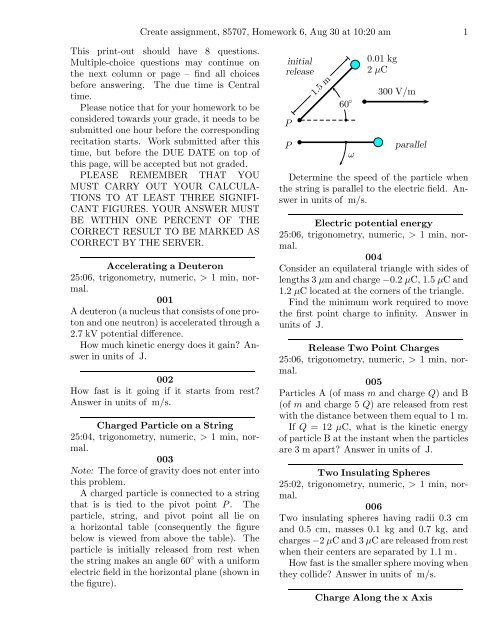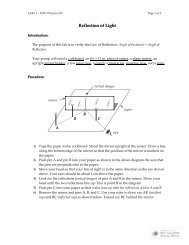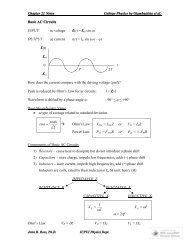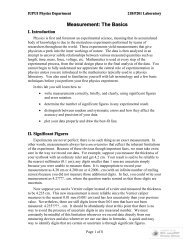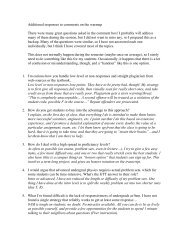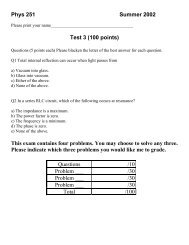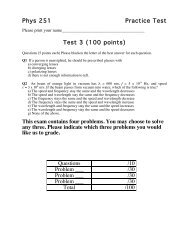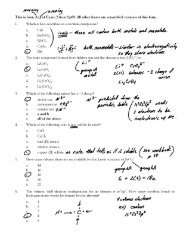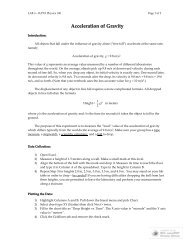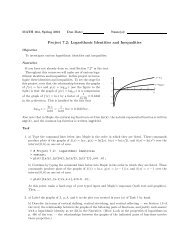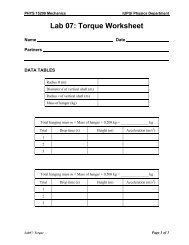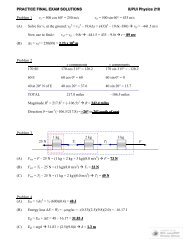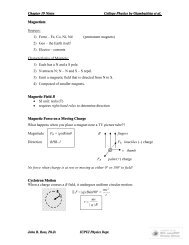Create assignment, 85707, Homework 6, Aug 30 at ... - Web Physics
Create assignment, 85707, Homework 6, Aug 30 at ... - Web Physics
Create assignment, 85707, Homework 6, Aug 30 at ... - Web Physics
Create successful ePaper yourself
Turn your PDF publications into a flip-book with our unique Google optimized e-Paper software.
<strong>Cre<strong>at</strong>e</strong> <strong>assignment</strong>, <strong>85707</strong>, <strong>Homework</strong> 6, <strong>Aug</strong> <strong>30</strong> <strong>at</strong> 10:20 am 1<br />
This print-out should have 8 questions.<br />
Multiple-choice questions may continue on<br />
the next column or page – find all choices<br />
before answering. The due time is Central<br />
time.<br />
Please notice th<strong>at</strong> for your homework to be<br />
considered towards your grade, it needs to be<br />
submitted one hour before the corresponding<br />
recit<strong>at</strong>ion starts. Work submitted after this<br />
time, but before the DUE DATE on top of<br />
this page, will be accepted but not graded.<br />
PLEASE REMEMBER THAT YOU<br />
MUST CARRY OUT YOUR CALCULA-<br />
TIONS TO AT LEAST THREE SIGNIFI-<br />
CANT FIGURES. YOUR ANSWER MUST<br />
BE WITHIN ONE PERCENT OF THE<br />
CORRECT RESULT TO BE MARKED AS<br />
CORRECT BY THE SERVER.<br />
Acceler<strong>at</strong>ing a Deuteron<br />
25:06, trigonometry, numeric, > 1 min, normal.<br />
001<br />
A deuteron (a nucleus th<strong>at</strong> consists of one proton<br />
and one neutron) is acceler<strong>at</strong>ed through a<br />
2.7 kV potential difference.<br />
How much kinetic energy does it gain? Answer<br />
in units of J.<br />
002<br />
How fast is it going if it starts from rest?<br />
Answer in units of m/s.<br />
Charged Particle on a String<br />
25:04, trigonometry, numeric, > 1 min, normal.<br />
003<br />
Note: The force of gravity does not enter into<br />
this problem.<br />
A charged particle is connected to a string<br />
th<strong>at</strong> is is tied to the pivot point P . The<br />
particle, string, and pivot point all lie on<br />
a horizontal table (consequently the figure<br />
below is viewed from above the table). The<br />
particle is initially released from rest when<br />
the string makes an angle 60 ◦ with a uniform<br />
electric field in the horizontal plane (shown in<br />
the figure).<br />
initial<br />
release<br />
P<br />
P<br />
1.5 m<br />
60 ◦<br />
ω<br />
0.01 kg<br />
2 µC<br />
<strong>30</strong>0 V/m<br />
parallel<br />
Determine the speed of the particle when<br />
the string is parallel to the electric field. Answer<br />
in units of m/s.<br />
Electric potential energy<br />
25:06, trigonometry, numeric, > 1 min, normal.<br />
004<br />
Consider an equil<strong>at</strong>eral triangle with sides of<br />
lengths 3 µm and charge −0.2 µC, 1.5 µC and<br />
1.2 µC loc<strong>at</strong>ed <strong>at</strong> the corners of the triangle.<br />
Find the minimum work required to move<br />
the first point charge to infinity. Answer in<br />
units of J.<br />
Release Two Point Charges<br />
25:06, trigonometry, numeric, > 1 min, normal.<br />
005<br />
Particles A (of mass m and charge Q) and B<br />
(of m and charge 5 Q) are released from rest<br />
with the distance between them equal to 1 m.<br />
If Q = 12 µC, wh<strong>at</strong> is the kinetic energy<br />
of particle B <strong>at</strong> the instant when the particles<br />
are 3 m apart? Answer in units of J.<br />
Two Insul<strong>at</strong>ing Spheres<br />
25:02, trigonometry, numeric, > 1 min, normal.<br />
006<br />
Two insul<strong>at</strong>ing spheres having radii 0.3 cm<br />
and 0.5 cm, masses 0.1 kg and 0.7 kg, and<br />
charges −2 µC and 3 µC are released from rest<br />
when their centers are separ<strong>at</strong>ed by 1.1 m .<br />
How fast is the smaller sphere moving when<br />
they collide? Answer in units of m/s.<br />
Charge Along the x Axis
<strong>Cre<strong>at</strong>e</strong> <strong>assignment</strong>, <strong>85707</strong>, <strong>Homework</strong> 6, <strong>Aug</strong> <strong>30</strong> <strong>at</strong> 10:20 am 2<br />
25:08, calculus, numeric, > 1 min, normal.<br />
007<br />
A charge of 5 nC is uniformly distributed<br />
along the x-axis from −2 m to 2 m.<br />
Wh<strong>at</strong> is the electric potential (rel<strong>at</strong>ive to<br />
zero <strong>at</strong> infinity) of the point <strong>at</strong> 5 m on the<br />
x-axis? Answer in units of V.<br />
Circle of Charge<br />
25:08, calculus, numeric, > 1 min, normal.<br />
008<br />
A charge of 3 µC is distributed uniformly<br />
along the circumference of a circle with a<br />
radius of 20 cm.<br />
The Coulomb constant is 8.98755 ×<br />
10 9 N · m 2 /C 2 .<br />
How much external energy is required to<br />
bring a charge of 25 µC from infinity to the<br />
center of the circle? Answer in units of J.


